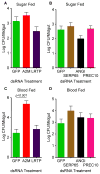Characterization of the Rel2-regulated transcriptome and proteome of Anopheles stephensi identifies new anti-Plasmodium factors
- PMID: 24998399
- PMCID: PMC4143444
- DOI: 10.1016/j.ibmb.2014.06.005
Characterization of the Rel2-regulated transcriptome and proteome of Anopheles stephensi identifies new anti-Plasmodium factors
Abstract
Mosquitoes possess an innate immune system that is capable of limiting infection by a variety of pathogens, including the Plasmodium spp. parasites responsible for human malaria. The Anopheles immune deficiency (IMD) innate immune signaling pathway confers resistance to Plasmodium falciparum. While some previously identified Anopheles anti-Plasmodium effectors are regulated through signaling by Rel2, the transcription factor of the IMD pathway, many components of this defense system remain uncharacterized. To begin to better understand the regulation of immune effector proteins by the IMD pathway, we used oligonucleotide microarrays and iTRAQ to analyze differences in mRNA and protein expression, respectively, between transgenic Anopheles stephensi mosquitoes exhibiting blood meal-inducible overexpression of an active recombinant Rel2 and their wild-type conspecifics. Numerous genes were differentially regulated at both the mRNA and protein levels following induction of Rel2. While multiple immune genes were up-regulated, a majority of the differentially expressed genes have no known immune function in mosquitoes. Selected up-regulated genes from multiple functional categories were tested for both anti-Plasmodium and anti-bacterial action using RNA interference (RNAi). Based on our experimental findings, we conclude that increased expression of the IMD immune pathway-controlled transcription factor Rel2 affects the expression of numerous genes with diverse functions, suggesting a broader physiological impact of immune activation and possible functional versatility of Rel2. Our study has also identified multiple novel genes implicated in anti-Plasmodium defense.
Keywords: Innate immunity; Mosquitoes; Plasmodium; Proteome; Rel2; Transcriptome; Transgenesis.
Copyright © 2014 Elsevier Ltd. All rights reserved.
Conflict of interest statement
The authors have declared that no competing interests exist.
Figures





Similar articles
-
Caspar controls resistance to Plasmodium falciparum in diverse anopheline species.PLoS Pathog. 2009 Mar;5(3):e1000335. doi: 10.1371/journal.ppat.1000335. Epub 2009 Mar 13. PLoS Pathog. 2009. PMID: 19282971 Free PMC article.
-
Anopheles Imd pathway factors and effectors in infection intensity-dependent anti-Plasmodium action.PLoS Pathog. 2012;8(6):e1002737. doi: 10.1371/journal.ppat.1002737. Epub 2012 Jun 7. PLoS Pathog. 2012. PMID: 22685401 Free PMC article.
-
Transcriptome analysis of Aedes aegypti transgenic mosquitoes with altered immunity.PLoS Pathog. 2011 Nov;7(11):e1002394. doi: 10.1371/journal.ppat.1002394. Epub 2011 Nov 17. PLoS Pathog. 2011. PMID: 22114564 Free PMC article.
-
NF-κB-Like Signaling Pathway REL2 in Immune Defenses of the Malaria Vector Anopheles gambiae.Front Cell Infect Microbiol. 2017 Jun 21;7:258. doi: 10.3389/fcimb.2017.00258. eCollection 2017. Front Cell Infect Microbiol. 2017. PMID: 28680852 Free PMC article. Review.
-
[Innate immune defense in anopheline mosquitoes against plasmodium infection].Zhongguo Ji Sheng Chong Xue Yu Ji Sheng Chong Bing Za Zhi. 2006 Oct;24(5):370-4. Zhongguo Ji Sheng Chong Xue Yu Ji Sheng Chong Bing Za Zhi. 2006. PMID: 17361820 Review. Chinese.
Cited by
-
Gene Drive for Mosquito Control: Where Did It Come from and Where Are We Headed?Int J Environ Res Public Health. 2017 Sep 2;14(9):1006. doi: 10.3390/ijerph14091006. Int J Environ Res Public Health. 2017. PMID: 28869513 Free PMC article. Review.
-
Inhibition of Asaia in Adult Mosquitoes Causes Male-Specific Mortality and Diverse Transcriptome Changes.Pathogens. 2020 May 15;9(5):380. doi: 10.3390/pathogens9050380. Pathogens. 2020. PMID: 32429180 Free PMC article.
-
Genome annotation improvements from cross-phyla proteogenomics and time-of-day differences in malaria mosquito proteins using untargeted quantitative proteomics.PLoS One. 2019 Jul 29;14(7):e0220225. doi: 10.1371/journal.pone.0220225. eCollection 2019. PLoS One. 2019. PMID: 31356616 Free PMC article.
-
Evolution and assembly of Anopheles aquasalis's immune genes: primary malaria vector of coastal Central and South America and the Caribbean Islands.Open Biol. 2023 Jul;13(7):230061. doi: 10.1098/rsob.230061. Epub 2023 Jul 12. Open Biol. 2023. PMID: 37433331 Free PMC article.
-
Genetic modification of Anopheles stephensi for resistance to multiple Plasmodium falciparum strains does not influence susceptibility to o'nyong'nyong virus or insecticides, or Wolbachia-mediated resistance to the malaria parasite.PLoS One. 2018 Apr 10;13(4):e0195720. doi: 10.1371/journal.pone.0195720. eCollection 2018. PLoS One. 2018. PMID: 29634777 Free PMC article.
References
-
- Altschul SF, Gish W, Miller W, Myers EW, Lipman DJ. Basic local alignment search tool. J Mol Biol. 1990;215:403–410. - PubMed
-
- Armstrong PB, Quigley JP. Alpha2-macroglobulin: an evolutionarily conserved arm of the innate immune system. Dev Comp Immunol. 1999;23:375–390. - PubMed
-
- Bano N, Romano JD, Jayabalasingham B, Coppens I. Cellular interactions of Plasmodium liver stage with its host mammalian cell. Int J Parasitol. 2007;37:1329–1341. - PubMed
Publication types
MeSH terms
Substances
Grants and funding
LinkOut - more resources
Full Text Sources
Other Literature Sources
Miscellaneous

